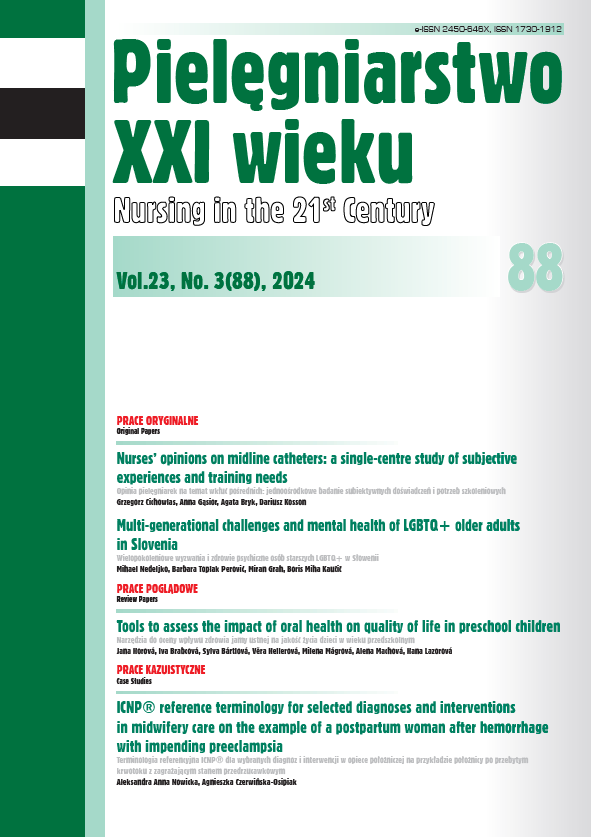Wpływ czynników społeczno-ekonomicznych na plany prokreacyjne Polaków w wieku reprodukcyjnym
DOI:
https://doi.org/10.2478/pielxxiw-2024-0030Słowa kluczowe:
płodność, planowanie rodziny, czynniki społeczno-ekonomiczne, zdrowie reprodukcyjne, trendy demograficzneAbstrakt
WPŁYW CZYNNIKÓW SPOŁECZNO-EKONOMICZNYCH NA PLANY PROKREACYJNE POLAKÓW W WIEKU REPRODUKCYJNYM
Cel pracy. Badanie miało na celu poznanie stosunku Polaków do planowania potomstwa oraz zbadanie czynników socjoekonomicznych, determinujących chęć posiadania dzieci w przyszłości.
Materiał i metody. W badaniu przeprowadzonym od marca do września 2023 roku wzięło udział 735 Polaków w wieku reprodukcyjnym. Badanie przeprowadzono metodą CAWI.
Wyniki. Najliczniejszą grupą wśród badanych były osoby między 18. a 25. rokiem życia. Większość respondentów stanowiły kobiety, osoby ze średnim lub wyższym wykształceniem, oraz mieszkające w miastach. Prawie połowa badanych pozostaje w związkach nieformalnych. Stwierdzono istotną korelację między sytuacją fi nansową a planowaniem potomstwa. Osoby z dochodem pozwalającym na oszczędzanie pieniędzy, najchętniej deklarują chęć posiadania dzieci. Badanie wykazało znaczący związek między sytuacją mieszkaniową a chęcią posiadania dzieci. Posiadanie własnego domu oraz możliwość pogodzenia pracy z życiem rodzinnym wpływają na planowanie potomstwa. Status relacji intymnych miał istotny wpływ na chęć założenia rodziny. Respondenci pozostający w związku nieformalnym wykazywali największą chęć posiadania dzieci.
Wnioski. Najważniejszym czynnikiem determinującym plany prokreacyjne Polaków jest stabilne źródło dochodów. Z kolei programy socjalne oferowane przez państwo są uznawane za czynnik mający najmniejszy wpływ na podjęcie decyzji o potomstwie. Badania przeprowadzone na grupach Polaków potwierdzają te wyniki.
Bibliografia
1. Ambroch M, Czermak G, Lisiak E, i wsp. Statystyczny na zlec. GU. 100 lat Polski w liczbach, 1918-2018. Warszawa; Główny Urząd Statystyczny, 2018.
2. European Institute for Gender Equality. Gender Equality Index; 2023, p. 1-196.
3. Owsiejczyk A. Czynniki wpływające na postawy młodych ludzi wobec prokreacji. Młodzież a rodzina, Rocznik socjologii rodziny XIX, UAM, Poznań; 2008; 158-172.
4. Slany K. Socjologiczno-demograficzne uwarunkowania postaw prokreacyjnych w Polsce. Analiza diachroniczna.: Uwarunkowania przemian demograficznych w województwie małopolskim Postawy prokreacyjne Materiały z III Kongresu Demograficznego, Warszawa: Główny Urząd Statystyczny; 2023, s. 67-87.
5. Kluzowa K, Krystyna S. Przemiany realizacji funkcji prokreacyjnej w rodzinie. [w:] Mierzwiński B, Dybowska E. (red.). Oblicze współczesnej rodziny polskiej. Kraków: WAM; 2004, s. 63-95.
6. Organisation for Economic Co-operation and Development. Family Database: Fertility rates. 2023. p. https://www.oecd.org/en/data/indicators/fertility-rates.html?oecdcontrol-00b22b2429-var3=2023
7. Skibiński A. Uwarunkowania postaw prokreacyjnych i matrymonialnych młodzieży akademickiej województwa Śląskiego. Stud. Ekon. 2017; 309: 17-27.
8. Izdebski Z, Wąż K. Plany prokreacyjne i stosowanie antykoncepcji przez Polaków w wieku reprodukcyjnym. Zesz. Nauk. Ochr. Zdrowia Zdr. Publiczne i Zarz. 2017; 15(2): 126-134.
9. Lisiak E, Mortyz-Balska E. Polska w liczbach 2023. Główny Urząd Statystyczny Departament Opracowań Statystycznych. Warszawa: Zakład Wydawnictw Statystycznych, 2023.
10. Fihel A, Kiełkowska M, Kordasiewicz A, et al. Determinanty spadku płodności w Polsce - próba syntezy. Studia Demogr. 2017; 2(172): 35-69.
11. Instytut Badań nad Gospodarką Rynkową. Rodzina i dzieci w Polsce 2023. Gdańsk: Pomorski Przegląd Gospodarczy; 2023.
12. Stępnik K. Decyzje prokreacyjne młodych Polaków w zmieniającym się kontekście kulturowym. Kraków: Uniwersytet Jagielloński, 2019.
13. Goliczewska A, Szablewska AW. Analysis of biopsychosocial factors in relation to the procreation plans of Poles of reproductive age. Nurs. Probl./Probl. Pielęgniarstwa. 2024; 32(2): 104-110.
14. Mason A, Lee R, Network NTA. Six ways population change will affect the global economy. Popul. Dev. Rev. 2022; 48(1): 51-73.
15. Bergsvik J, Fauske A, Hart RK. Can policies stall the fertility fall? A systematic review of the (quasi‐) experimental literature. Popul. Dev. Rev. 2021; 47(4): 913-964.
16. Johnson-Hanks J. Demographic transitions and modernity. Annu Rev. Anthropol. 2008; 37(1): 301-315.
17. Boivin J, Buntin L, Kalebic N. What makes people ready to conceive? Findings from the International Fertility Decision-Making Study. Reprod. Biomed. Soc. Online. 2018; 6: 90-101.
18. Köppen K. The compatibility between work and family life - an empirical study of second birth risks in West Germany and France. MPIDR Work Pap. 2004; 49 (WP 2004-015): 1-41.
19. Rękas M. Tax instruments as an element of pro-family policy in France and in Poland. Pr. Nauk Uniw. Ekon. we Wrocławiu. 2014; 346: 224-234.
20. Toulemon L, Pailhé A, Rossier C. France: High and stable fertility. Demogr. Res. 2008; 19: 503-556.
21. Szukalski P. Czy „Rodzina 500+” zmieni sytuację demograficzną Polski? Łódź, Demografia i Gerontologia Społeczna -Biuletyn Informacyjny; 2016.
22. Lappegård T, Rønsen M, Skrede K. Fatherhood and fertility. Father. A J. Theory. Res. Pract. about Men as Father. 2011; 9(1): 103-120.
23. Lappegård T, Rønsen M. Socioeconomic differences in multipartner fertility among Norwegian men. Demography. 2013; 50(3): 1135-1153.
24. Poston Jr DL, Chang C-F. Bringing males in: A critical demographic plea for incorporating males in methodological and theoretical analyses of human fertility. Crit. Demogr. 2005; 1(1): 1-15.
25. Jalovaara M, Fasang AE. Family life courses, gender, and mid-life earnings. Eur. Sociol. Rev. 2020; 36(2): 159-178.
26. Bernhardt E, Goldscheider F. Gender equality, parenthood attitudes, and first births in Sweden. Vienna Yearb Popul Res. 2006; 19-39.
27. Lappegård T, Kristensen AP, Dommermuth L, et al. The impact of narratives of the future on fertility intentions in Norway. J. Marriage Fam. 2022; 84(2): 476-493.
28. Adsera A. An economic analysis of the gap between desired and actual fertility: The case of Spain. Rev. Econ. Househ. 2006; 4(1): 75-95.
29. Hu L-C, Chiang Y-L. Having children in a time of lowest-low fertility: Value of children, sex preference and fertility desire among Taiwanese young adults. Child Indic. Res. 2021; 14(2): 537-554.
30. Ustawa z dnia 26 czerwca 1974 r. Kodeks pracy, t.j. z dnia 31 lipca 2023 r. (Dz.U. z 2023 r., poz. 1465).
31. Ustawa z dnia 13 marca 2003 r. o szczególnych zasadach rozwiązywania z pracownikami stosunków pracy z przyczyn niedotyczących pracowników, t.j. z dnia 15 października 2018 r. (Dz.U. z 2018 r., poz. 1969).
32. Natividade JC, Londero-Santos A, Carvalho NM de, et al. Desire to have children: validity evidence of an instrument. Psicol. Clínica. 2020; 32(2): 273-294.
33. Zygmunt A. Oczekiwania wobec polityki rodzinnej w kontekście decyzji i planów prokreacyjnych mieszkańców województwa śląskiego. Wrocławskie Stud. Politol. 2020; 29: 91-107.
Pobrania
Opublikowane
Numer
Dział
Licencja
Prawa autorskie (c) 2024 Autorzy

Utwór dostępny jest na licencji Creative Commons Uznanie autorstwa 4.0 Międzynarodowe.




